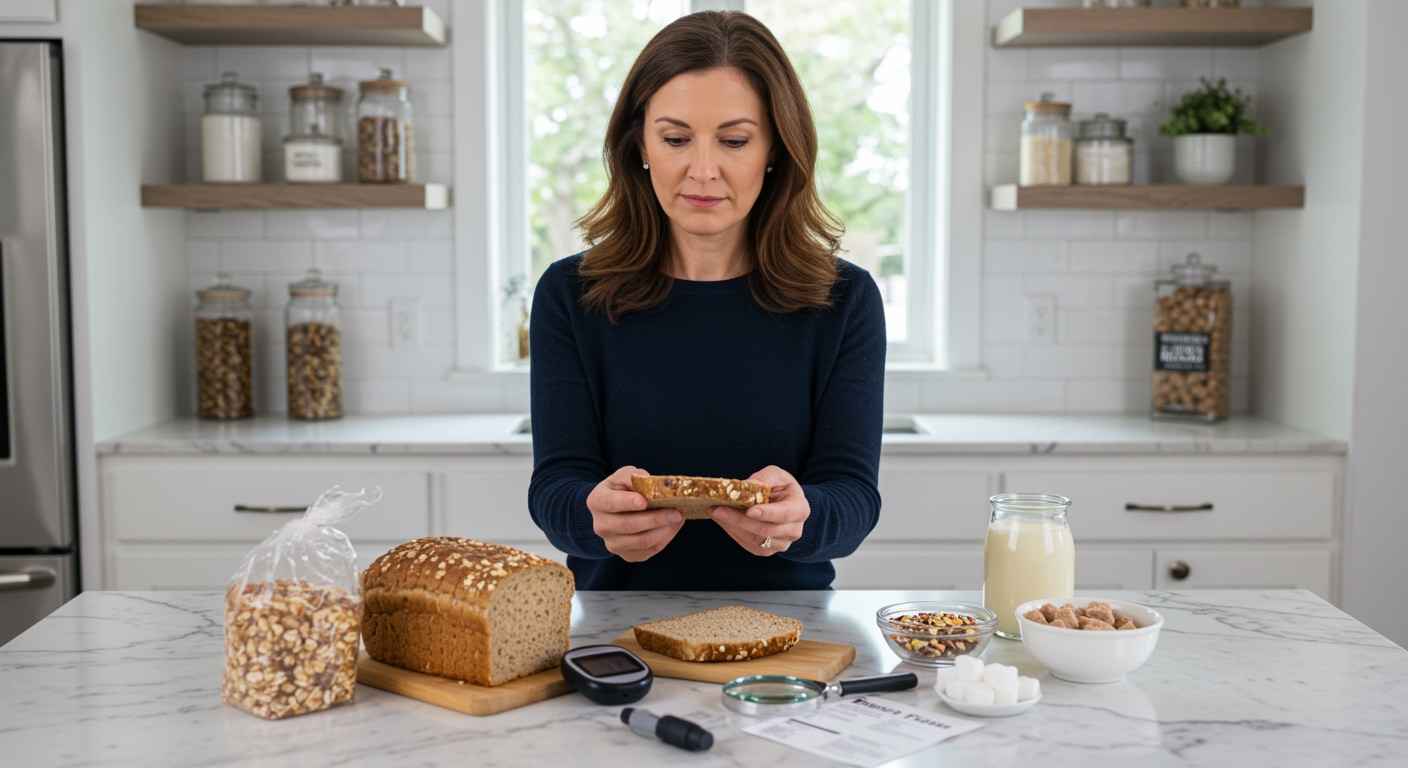✪ Key Takeaway: Multigrain bread can be good for diabetes if it contains whole grains and fiber, but many commercial versions are just white bread with added grains.
Introduction
You walk down the bread aisle and see “multigrain” plastered across dozens of loaves.
Your doctor told you to choose healthier bread options for your diabetes, so you assume multigrain must be the answer.
Hi, I’m Abdur, your nutrition coach and today I’m going to explain whether multigrain bread is actually good for diabetes and what you need to know before making your next purchase.
What Makes Multigrain Bread Different From Regular Bread?
Multigrain bread contains multiple types of grains beyond just wheat.
Common grains include oats, barley, millet, quinoa, and various seeds like flax or sunflower.
However, the term “multigrain” tells you nothing about processing methods or fiber content.
Many commercial multigrain breads start with refined white flour as their main ingredient.
Manufacturers then add small amounts of other grains to justify the multigrain label.
This means you could be eating essentially white bread with a few decorative grains sprinkled on top.
✪ Pro Tip: Always check if the first ingredient listed is whole grain flour, not enriched or refined flour.
How Does Multigrain Bread Affect Blood Sugar Levels?
The glycemic impact of multigrain bread depends entirely on its actual composition.
True whole grain multigrain bread contains more fiber, which slows down glucose absorption in your intestines.
Fiber creates a gel-like substance in your digestive tract that acts as a barrier between digestive enzymes and starches.
This process results in a more gradual blood sugar rise instead of the sharp spike you get from refined grains.
Research shows that whole grain consumption can improve insulin sensitivity over time.
However, fake multigrain bread made primarily from refined flour will spike your blood sugar just like white bread.
The small amounts of added grains in processed multigrain bread provide minimal glycemic benefit.
✪ Fact: Whole grain bread can reduce post-meal blood sugar spikes by up to 30% compared to white bread.
Which Ingredients Should You Look For In Diabetic-Friendly Multigrain Bread?
The ingredient list reveals everything you need to know about any multigrain bread.
Look for breads where the first ingredient is whole wheat flour, whole oat flour, or another whole grain flour.
Beneficial additions include flaxseeds, chia seeds, and psyllium husk, which add soluble fiber.
Avoid breads with enriched flour, wheat flour, or any flour that doesn’t specify “whole” as the main ingredient.
High fructose corn syrup, sugar, and honey should appear far down the ingredient list or not at all.
Look for at least 3 grams of fiber per slice and less than 15 grams of total carbohydrates.
Sodium content should stay below 200 milligrams per slice to support overall cardiovascular health.
✪ Note: Ingredients are listed by weight, so the first few ingredients make up most of the bread.
What Are The Best Alternatives To Commercial Multigrain Bread?
Making your own multigrain bread gives you complete control over ingredients and processing.
You can combine whole wheat flour with oat flour, almond flour, and ground flaxseeds for maximum nutritional benefit.
Sprouted grain breads offer another excellent option because sprouting reduces antinutrients and increases mineral absorption.
The sprouting process also breaks down some starches, potentially lowering the bread’s glycemic impact.
Sourdough multigrain bread provides additional benefits through fermentation.
The fermentation process pre-digests some carbohydrates and creates beneficial compounds that may improve glucose metabolism.
Cloud bread made from eggs and cream cheese offers a virtually carb-free alternative when you want the bread experience without any blood sugar impact.
✪ Pro Tip: Freeze homemade multigrain bread in individual slices for convenient portion control.
How Should You Incorporate Multigrain Bread Into A Diabetic Diet?
Portion control remains crucial even with the healthiest multigrain bread.
One slice of quality multigrain bread should fit within your daily carbohydrate budget.
Pair your bread with protein and healthy fats to further slow glucose absorption.
Avocado, nut butter, or lean turkey create balanced combinations that minimize blood sugar spikes.
Timing matters too – consuming multigrain bread earlier in the day gives your body more time to process the carbohydrates.
Monitor your individual response by testing blood sugar before eating and two hours after.
This personal data helps you determine whether specific multigrain breads work well for your metabolic profile.
✪ Fact: Eating bread with protein can reduce blood sugar spikes by up to 50% compared to eating bread alone.
The Bottom Line
Multigrain bread can be good for diabetes, but only when it contains genuine whole grains and adequate fiber.
Real nutrition happens in the ingredient list, not on the front label marketing claims.
I would love to hear about your experiences with different types of bread and how they affect your blood sugar – please share your thoughts and questions in the comments below.
References
At NutritionCrown, we use quality and credible sources to ensure our content is accurate and trustworthy. Below are the sources referenced in creating this article:
- PubMed: Whole Grain Consumption and Risk of Cardiovascular Disease
- Diabetes Care: Whole Grain Processing and Glycemic Control
- BMJ: Whole Grain Intake and Mortality
- Food and Nutrition Journal: Glycemic and Insulinemic Responses of Multi-grain Bread





